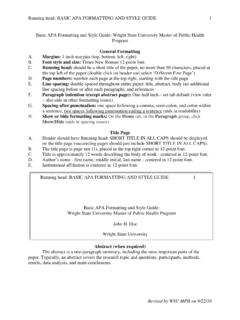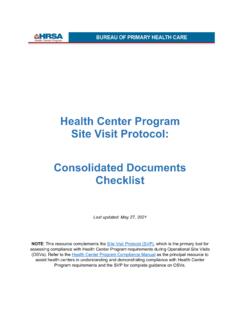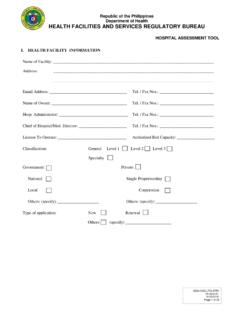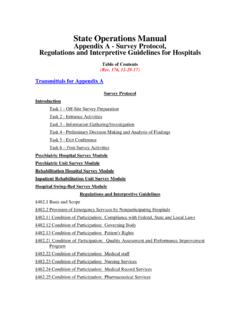Transcription of Organizational Chart and Quality Safety Departments
1 15 Participating Site, Miami Valley Hospital, part of the Premier Health System Organizational Chart and Quality Safety Departments15 2 President & Chief Executive Officer James PancoastPremier System Support Organizational ChartExecutive VP & COO Mary BoosalisPresident MVH Mark ShakerPresident AMC Carol TurnerPresident GSH Eloise BronerPresident UVMC Becky RiceSystem Vice President Service Lines Tom ParkerService Line ExecutivesSystem Vice President, Chief Medical Officer Tammy Lundstrom, Vice President, Chief Academic Officer Molly Hall, Vice President, Chief Human Resource Officer Barbara JohnsonSystem Vice President, Operations Innovation Michael UhlSenior Vice President & CFO Tom DuncanSenior Vice President Value Based Services Mike MaibergerSystem Vice President, Business Development Craig SelfSystem Vice President, Chief Legal Officer Dale CreechSystem Vice President, Chief Com-munications Officer Diane EwingSystem Vice President, Chief Compliance/ERM Officer Dianne JudgePublic Affairs Director Julie Liss-KatzSystem Vice President, Controller Mike SimsSystem Vice President, CIO Gary GinterSystem Vice President, Revenue Cycle Renee GeorgeSystem Vice President, Managed Care Mark ShawSystem Vice President Chief Purchasing Officer Tom NashVice President Hopsital Finance Scott Shelton Tim SniderAdministrator, Audit Julie BillingtonDirector, Real Estate Buddy LaChance15 3 President & Chief Executive Officer Mark ShakerMiami Valley Hospital Organizational ChartExec.
2 VP & Chief Operating Officer Mikki ClancyChief Operating Officer MVH South Joann RingerVice President clinical Consulting Gary D Collier, President & Chief Nursing Officer Jolyn AngusChief Medical Officer Mark Williams, MVH Foundation Jenny LewisStaff with Dual Reporting to Premier System SupportVice President Hospital Finance Scott SheltonDirector Human Resources Stacey LawsonVice President Corporate Counsel Geoff WalkerDirector Quality Management Ed Syron15 4 System Vice President, Chief Medical Officer Tammy Lundstrom, , CMO Organizational ChartVice President Quality InnovationVice President Medical Affairs & Chief Medical Officer AMCJ effrey Hoffman, President Medical Affairs & Chief Medical Officer UVMCDan Bailey, President Medical Affairs & Chief Medical Officer MVHMark Williams, President Medical Affairs & Chief Medical Officer GSH Daniel Schoulties, Patient Experience Melissa Tallmadge15 5 Quality and Medical Safety PlanI.
3 INTRODUCTIONA. PURPOSEP remier Health Quality and Safety plan is designed to support the mission of Premier Health. This plan will be implemented through the integration of the performance improvement philosophy, which is aimed at improving the Quality of the system s governance, manage-ment, clinical and support processes and medical Safety activities. The purpose of this plan is to provide guidelines to ensure high Quality care, eliminate preventable harm to patients, minimize risk to the patients, employees, and the organization, and promote cost effectiveness. It also includes professional/peer review; review of professional practices to reduce morbidity, mortality, and improve Quality care; and review of professional practices to prevent potential GUIDING STATEMENTSP remier Health Quality StatementPremier Health is committed to ensuring the safest, highest Quality of care for its patients that embodies the Institute of Medicine principles of best healthcare.
4 Our Patient Experience encompasses Safety , Quality , Service and Inclusion. Premier Health will imple-ment all nationally recognized Safety best practices and will strive to eliminate all preventable harm to our patients, through standard-ization of care, continuous process improvement, advanced information technology and a culture of Safety and fairness. Premier Health promises to deliver care that is built on the foundation of our core values. Everyone deserves our respect, integrity, compas-sion, and excellence. Premier Health is committed to providing correct, evidence based care that is safe by elimination of all prevent-able harm, adherence to national and evidence based best practices, regulatory s/accreditation readiness and care that are patient/family centered. Premier Health clinical Safety Premier Health is committed to promoting the Safety of all patients, visitors, volunteers, healthcare workers, and trainees. This com-mitment includes incorporating Safety concerns as a component of newly designed and redesigned activities.
5 The organization-wide clinical Safety plan is designed to reduce medical/health system errors and hazardous conditions by utilizing continuous improvement methods and strategies for medical Safety initiatives that are ongoing, proactive and in response to actual occurrences. Our goal is to have zero preventable harm. In order to achieve our desired outcomes the leaders of Premier Health will ensure that expectations for performance and behaviors are clear, all members of Premier Health have the knowledge and skills necessary to perform the task and an effective accountability system is in place to build and sustain a system-wide culture of Safety . II OVERVIEW The Quality and clinical plan is comprised of clinical Quality , patient Safety , infection control, accreditation and regulatory preparedness, environment of care and emergency management; involves all hospital Departments and services (including those services under con-tract or arrangement), ambulatory and home health services; and focuses on indicators related to improved health outcomes and the prevention of medical errors and adverse events.
6 Premier Health System Leadership promotes an Organizational Safety climate which: n Encourages recognition, reporting, and acknowledgement of risks to patient/visitor and employee Safety and medical/health system Initiates/monitors actions to reduce these Reports findings internally and actions are Promotes a non-punitive environment for reporting and follow-up of medical errors and adverse Supports staff that has experienced a clinical health system Educates staff to assure that all members of the healthcare team participate in the Assures that patients/families are informed about the results of care, including unexpected outcomes and clinical healthcare 6A. DEVELOPMENT OF Quality AND Safety PLANC riteria used to prioritize performance improvement and medical Safety activities selected are based on one or more of the following:n Areas identified as high volume, high risk, or problem prone; considering the incidence, prevalence and severity of problems in those Patient Safety , health outcomes and Quality of caren Internal and external customer satisfactionn Patient and family complaints and grievances.
7 N Leadership patient Safety rounds and daily check-insn Objectives and targets for Quality and environmental management systemn ResourcesCriteria from external sources, include, but are not limited to:n Center for Medicare and Medicaid Services (CMS)n The Joint Commission (TJC)n Agency for Healthcare Research and Quality (AHRQ)n Centers for Disease Control and Prevention (CDC)n Institute for Healthcare Improvement (IHI)n Institute for Safe Medication Practices (ISMP)n Emergency Care Research Institute (ECRI) n National Forum for Healthcare Quality Measurement and Reporting (NQF)n National Database Nursing Quality Indicators (NDNQI)n Occupational Safety and Health Administration (OSHA/MIOSHA)n Ohio Quality Improvement Organization (KePRO)n Ohio department of Health (ODH)n Ohio Hospital Association (OHA)n Ohio Patient Safety Institute (OPSI) n Greater Dayton Area Hospital Association (GDAHA)n Published literatureIII. STRUCTURE A. Quality and clinical Safety Organizational Structure Premier Health supports the continuous improvement philosophy, which defines Quality as the on-going improvement of all processes.
8 All performance improvement and medical Safety efforts are promoted throughout the system and supported by the Board, Medical Staff and leadership team. Performance improvement at Premier Health is system, hospital, department and unit based. Senior leadership ensures that the Quality , Safety and environmental plans are communicated and understood within the organization. Information flow occurs as outlined in the Roles and Responsibilities section of this plan. Premier Health provides resources for an ongoing comprehensive performance improvement and medical Safety plan. Performance improvement activities are tracked and measures of success reported to ensure that performance is sustained and learning occurs throughout the system and hospital. B. ROLES AND RESPONSIBILITIES1. Governing Body Leadership: Final authority and responsibility for the Quality of patient care and Safety of patients and employees at Premier Health rests with its Board of Trustees.
9 Trustees assign specific responsibility for day-to-day management of performance improvement activities to the medical staff and site leadership through the individual Hospital Boards. 2. Individual Facility Hospital Medical Executive Committee: The individual site organized medical staff is responsible for overseeing the Quality of care provided by individuals with privileges. The facility s Medical Executive Committee (MEC) comprises both appointed and elected medical staff leadership as outlined in each facility s Medical Staff By-laws. Premier Health Medical Executive Committees receive reports from hospital operations committees related to clinical improvement physician performance, including GME. When appropriate the MEC also provides oversight for the Quality of care, treatment, and services provided by practitioners with privileges, maintain credentialing through the offices of medical affairs and provides for a uniform Quality of care, treatment, and services within each facility.
10 Hospital medical staff is engaged in activities to measure, assess, and improve 15 7performance on a departmental, hospital, and organization-wide basis. Some of these activities include measurement of outcomes and processes with respect to:n Medical assessment and treatment of Use of information about adverse privileging decisions for any practitioner privileged through the medical staff Use of Use of blood/blood Operative and other Appropriateness of clinical practice Significant departures from established patterns of clinical Use of developed criteria for Sentinel event Patient Safety Education of patients and Coordination of care, treatment, and services with other practitioners and hospital personnel, as relevant to the care, treatment and services of an individual Accurate, timely, and legible completion of patient s medical Review of findings of the assessment process that are relevant to an individual s performance.








